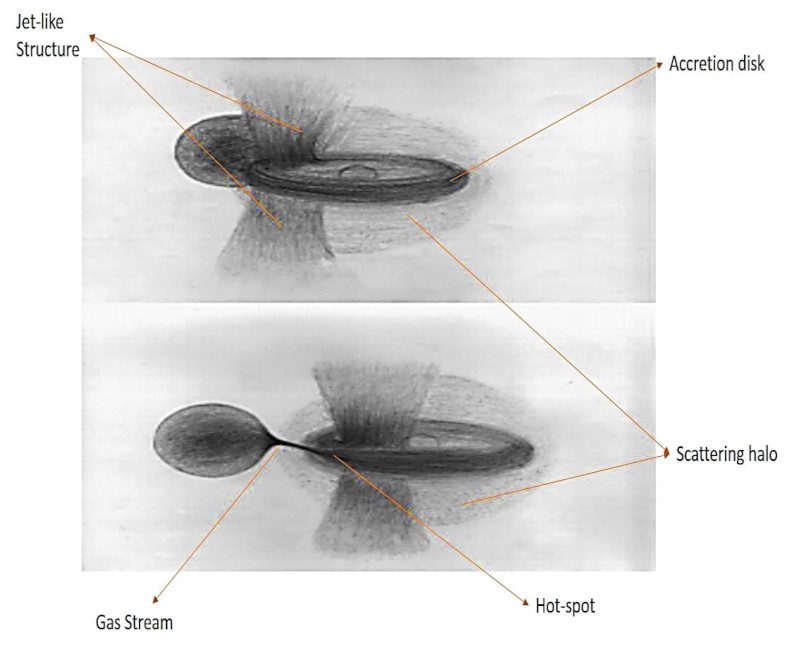For beginning amateur astronomers, binary stars are of attraction when using a telescope. Separating close binary stars using a small to medium sized telescope is like a sports discipline. Observations of the proper motion of wider binaries over decades from astrometric measures are a nice observing field for the patient amateur astronomer, where he or she can contribute scientific results worth to be published.
When looking at the stars with visual or photographic observation, many of the properties of the stars in the night sky remain hidden to the observer. This is especially true for very close binaries, which cannot be resolved with a small amateur telescope. Spectroscopic analysis of light is the Swiss army knife of astronomy. Many secrets of astronomical properties of stellar objects or gaseous nebulae can be deciphered even using a small to medium sized telescope by the addition of a prism or grating spectrograph attached to a telescope.
Very close binaries offer nice features from spectroscopic analysis, that can be studies only from spectroscopic observations. One of these special cases are B-emission line stars, like the well known star beta Lyr. The primary star of ß Lyr is a star of spectral type B6-B8II of 3M⊙ and the secondary is a 13M⊙ B0. 5V star.M⊙ denotes the unit of a solar mass and indicates the size and mass of the two stellar components of ß Lyr are much larger, that our Sun. The binary stars are surrounded by gas pulled by gravitation from the stellar atmosphere of (at least) one of the two binary stars. The distributed gas is now forming an accretion disc.
Figure 1: Artist view on the constellation of the close binary ß Lyr (taken from Putra, 2019).
Interstellar gas is ionized from the UV light of a hot stars of spectral types O and B. This effect is well known as extended gaseous nebulae in the night sky. In case of ß Lyr two hot stars of spectral type Bx are illuminating the gas. The gas in turn now adds emission lines to the composite spectrum of both stars. ß Lyr is not the only Be type binary. There are a lot more of the bright binaries that show emission llines spectra like ß Lyr. I will just show a small collection of stellar spectra.
Figure 2: Composition of stellar spectra of certain well-known bright stars in the Northern hemisphere. Note the bright emission lines from the close emission line binaries ß Lyr, γ Cas, VV Cep, P Cyg and CH Cyg.
The spectra presented here are collected using an 8-inch VC200L modified Cassegrain telescope using an Alpy 600 spectrograph with a Canon DSLR attached. A color DSLR camera nicely presents the colored spectra and spectral properties and spectral lines can easily discovered. The red spectral line to the right represents the Hα spectral line of hydrogen gas. The yellow line is identified as Helium He-II emission line, that is not present for all five emission line binaries. The blue-green line to the left is the ionized Hβ line (again hydrogen emission). As you can see these lines correspond to absoprtion lines of single stars like the bright stars α Lyr and α Cyg. In a typical stellar atmosphere the gas absorbs light, in case of B-emission line stars the ionized distributed gas emits light that is ionized by hot companions (O, B) of the binary systems.
Observational data
| Telescope: | Vixen VC200L astrograph |
| Camera: | Canon EOS 60D, clear glass modification (internal filter removed), 400 ASA |
| Filter: | Astronomik UV/IR EOS block filter |
| Instrument | Shelyak Alpy 600 spectrograph |
| Calibration: | Dark subtraction |
| Image Processing: | none |
| Date of exposure: | 17 August 2015 |
| Software: | ArgusPro SE |
|
Remark: |
Spectra taken during star party at location of the Observatoire de l'Haute Provence. |
Literature
- Putra, S. P. (2019, November). Evolutionary study of binary star beta lyr. In Journal of Physics: Conference Series (Vol. 1351, No. 1, p. 012078). IOP Publishing.


